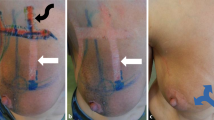Abstract
Objective
This multicenter study focuses on the use of a film-forming wound dressing in the form of a gel that can be applied directly to the area affected by radiation dermatitis, especially after skin breakdown. The primary objective of the study was to validate the efficacy of an innovative film-forming wound dressing used as monotherapy in the treatment of radiation dermatitis in patients with RTOG score 2.5 (± 0.5) confirmed by the investigator.
Methods
Fifty-four patients undergoing radiation therapy for different cancer types and developing radiation dermatitis were recruited in the study; they were treated with the film-forming wound dressing when reaching an RTOG score of 2.5 (± 0.5). The evaluation of radiation dermatitis during ongoing radiation therapy was performed using the RISRAS, which includes investigator-assessed items (erythema, dry desquamation, moist desquamation, necrosis) and patient-assessed items (pain, itch, burning sensation, affection of daily activities).
Results
The following study shows a statistically significant clinical improvement (p < 0.05) of the RISRAS score (− 16.9%), as well as of specific clinical outcomes, such as erythema (− 20.6%), pain (− 20.5%), itch (− 22.2%), and burning sensation (−24.7%), after the treatment with the film-forming wound dressing during ongoing radiation therapy. Other radiation dermatitis markers, such as inflammation (− 28.9%) and hydration (26.0%), appeared to be significantly influenced.
Conclusion
The use of the innovative film-forming wound dressing for radiation dermatitis treatment shows first time evidence of improving the RISRAS score during ongoing radiation therapy, showing major improvements in patients’ quality of life.









Similar content being viewed by others
Abbreviations
- CRF:
-
Case report form
- GCP:
-
Good clinical practice
- PIL:
-
Patient information leaflet
- RISRAS:
-
Radiation-Induced Skin Reaction Assessment Scale
- RTOG:
-
Radiation Therapy Oncology Group
- SD:
-
Standard deviation
- SEM:
-
Standard error mean
References
Naylor W, Mallett J (2001) Management of acute radiotherapy induced skin reactions: a literature review. Eur J Oncol Nurs 5(4):221–233
Porock D, Kristjanson L (1999) Skin reactions during radiotherapy for breast cancer: the use and impact of topical agents and dressings. Eur J Cancer Care 8(3):143–153
Cox JD, Stetz J, Pajak TF (1995) Toxicity criteria of the radiation therapy oncology group (RTOG) and the European organization for research and treatment of cancer (EORTC). Int J Radiat Oncol Biol Phys 31(5):1341–1346
Noble-Adams R (1999) Radiation-induced skin reactions 3: evaluating the RISRAS. Br J Nurs 8(19):1305–1312
Harris R. (2011) Summary of interventions for acute radiotherapy-induced skin reactions in cancer patients: a clinical guideline recommended for use by The Society and College of Radiographers. Society of Radiographers (http://www.sor.org). 1–5
Trueman E (2015 Apr 1) Management of radiotherapy-induced skin reactions. Int J Palliat Nurs 21(4):187–192
Bernier J, Bonner J, Vermorken JB, Bensadoun RJ, Dummer R, Giralt J, Kornek G, Hartley A, Mesia R, Robert C, Segaert S, Ang KK (2008) Consensus guidelines for the management of radiation dermatitis and coexisting acne-like rash in patients receiving radiotherapy plus EGFR inhibitors for the treatment of squamous cell carcinoma of the head and neck. Ann Oncol 19(1):142–149
Herst PM, Bennett NC, Sutherland AE, Peszynski RI, Paterson DB, Jasperse ML (2014) Prophylactic use of Mepitel Film prevents radiation-induced moist desquamation in an intra-patient randomised controlled clinical trial of 78 breast cancer patients. Radiother Oncol 110(1):137–143
Kedge EM (2009) A systematic review to investigate the effectiveness and acceptability of interventions for moist desquamation in radiotherapy patients. Radiography 15(3):247–257
Hymes SR, Strom EA, Fife C (2006) Radiation dermatitis: clinical presentation, pathophysiology, and treatment 2006. J Am Acad Dermatol 54(1):28–46
Yarbro CH, Wujcik D, Gobel BH.(2011) Cancer nursing: principles and practice. Jones & Bartlett Publishers
Ohri N, Rapkin BD, Guha C, Kalnicki S, Garg M (2016) Radiation therapy noncompliance and clinical outcomes in an urban academic cancer center. Int J Radiat Oncol Biol Phys 95(2):563–570
Author information
Authors and Affiliations
Corresponding author
Ethics declarations
Funding
The work was supported by Laboratorios LETI S.L.U. Dressings were supplied by Stratpharma AG, Switzerland free of charge.
Conflict of interest
The authors declare that they have no conflict of interest.
Ethical approval
All procedures performed in studies involving human participants were in accordance with the ethical standards of the institutional and/or national research committee and with the 1964 Helsinki declaration and its later amendments or comparable ethical standards.
Informed consent
Informed consent was obtained from all individual participants included in the study.
Rights and permissions
About this article
Cite this article
Quilis, A., Martín, J., Rodríguez, C. et al. Reducing radiation dermatitis during ongoing radiation therapy: an innovative film-forming wound dressing. J Radiat Oncol 7, 255–264 (2018). https://doi.org/10.1007/s13566-018-0356-5
Received:
Accepted:
Published:
Issue Date:
DOI: https://doi.org/10.1007/s13566-018-0356-5




